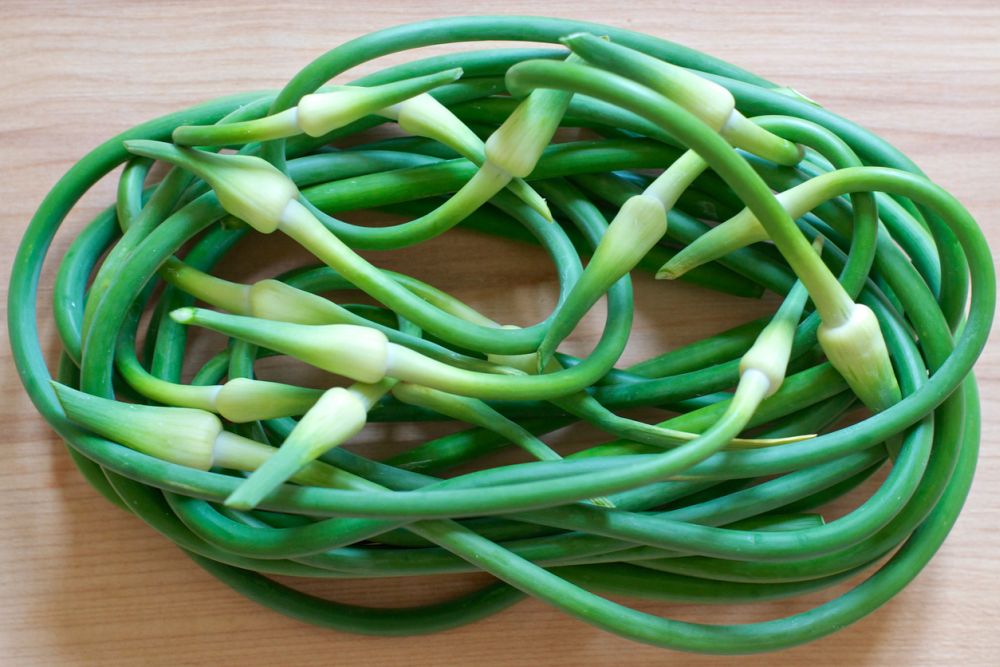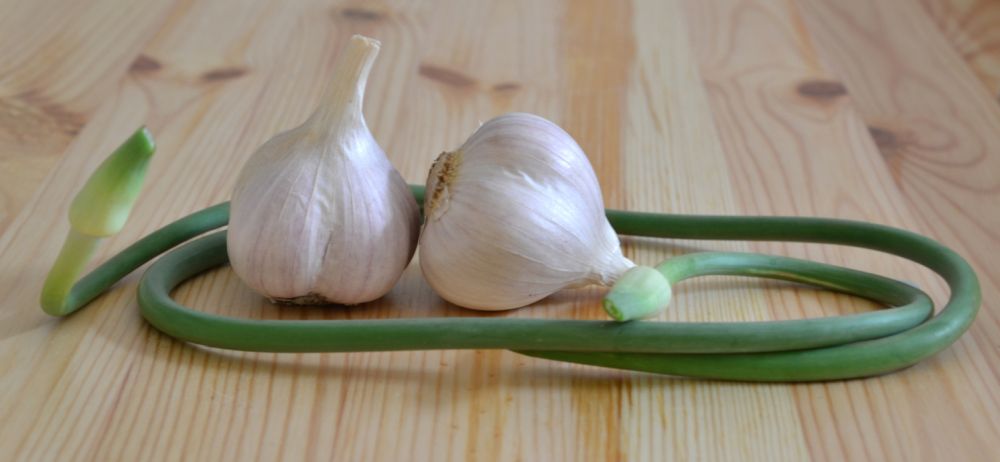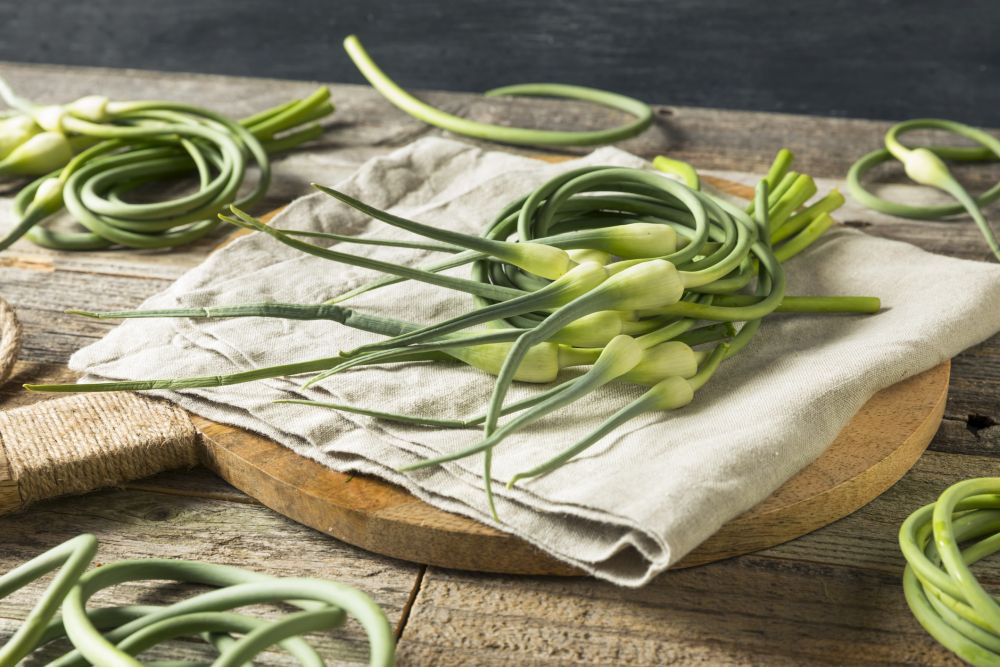Garlic Scapes – How to Grow and Harvest Garlic Scapes
It’s often a rewarding experience to grow garlic. But what about garlic scapes? Those hard stalks that grow out of the center of the garlic plant with no apparent purpose whatsoever, what are you supposed to do about them?
For one thing, they take up much of the garlic plant’s energy and resources which results in smaller bulbs. Moreover, the garlic cloves tend to have a pungent odor and taste, which renders them almost unusable in your many savory garlic dishes and recipes.
So does that mean that garlic scapes are a total waste of space and that they do more harm than good? Not really. They have their benefits, and instead of letting them ruin your garlic crop, you can harvest them and put them to good use. Read on to find out about garlic scapes and what you can do about them and with them.
What are Garlic Scapes?
Although farmers and gardeners may differ about the value or lack thereof that garlic scapes bring to the garlic crop, there’s no doubt that they have a role to play in the life of the garlic plant (Allium sativum). They mostly appear in the hard-neck garlic variety more than others. If you plant your garlic in late May, then garlic scapes will appear around the middle of June or within the first three weeks of the plant’s life.
Garlic scapes have a distinct look and color from the rest of the garlic leaves. In fact, they look more like onion leaves than garlic. The thick stalk grows out of the center of the plant and curls around itself into a loop where the top sports what looks like an elf’s white hat.
While it’s true they consume a lot of nutrition, they’re far from being useless. Once you see that white tapering end and the garlic scape looping around itself, that means it’s ready to harvest. Cut it with a sharp blade. Once you have collected a bunch of them, you can use them fresh to make garlic scape pesto. And if you have more garlic scapes than you need, you can put them in a ziplock bag and keep them in the freezer, where they will remain fresh for weeks.
Stages of Garlic Growth
But in order to understand the value of garlic scapes and why they grow out of certain garlic varieties at all, we need to take a closer look at the growth stages of the garlic plant. Unlike other members of the Amaryllidaceae family, garlic needs to establish early. When you plant garlic, you should do it as early as you can to give it enough time to grow robust roots and leaves before it focuses on developing the bulbs.
The length of the day has a great impact on that shift in the garlic plant’s development from leaves to bulbs. Once the day reaches 13 hours long and the air temperature rises above 70 degrees Fahrenheit, the plant starts making bulbs no matter how underdeveloped the leaves and roots are. So to ensure you have a healthy garlic crop and large bulbs, you should start your garlic patch at least three weeks before the season reaches the day length and temperature landmarks mentioned above.
The date the bulbs start to develop, and garlic scapes shoot out of the center of the plant vary depending on how warm the weather is. In cold zones, this might be as late as June or even early July. But the warm parts of the country can start to see the white elf hats of the garlic scapes as early as the end of May.
Mulching and Garlic Scapes
As we have mentioned agriculturalists, don’t agree on the importance of garlic scapes. But one thing they all have one opinion about is the need for mulching to improve the size of the garlic bulb. Here’s why mulching should be part of your regular garlic care and maintenance.
- Organic mulching maintains the temperature of the soil and protects the garlic bulbs against freezing and frost damage.
- In warm zones, mulching also keeps the soil cool and retains moisture in the soil long enough for the garlic roots to absorb it.
- Mulching also smoothers weeds and pests and prevents them from getting to the garlic bulbs. When the organic material breaks down, the resulting heat kills pests and bugs.
- All of this leads to better garlic crops and healthy garlic scapes that you can harvest regularly.
When to Harvest Garlic Scapes
Whether you have developed a taste for garlic scapes in your dishes or not, you should always harvest them to encourage the plant to focus on growing larger bulbs with better flavors. Some people believe that garlic scapes should be left to grow along with the plant to protect the bulbs against pests and diseases. But there’s no scientific evidence to that, and you need to cut them off as soon as they are ready.
Garlic scapes become mature and ready to harvest when they start to loop around themselves, and a white top caps their tapering end. Not all garlic varieties develop garlic scapes at the same time. That can be a good thing if you plan to cook the harvested stalks. But if you will only dispose of them, then collecting the garlic scapes can be time-consuming.
Whatever you choose to do with the stalks, you shouldn’t leave them on the plant until the flower opens up. The bulb will never grow in size after that, the flowers bloom, and the garlic scapes will become mostly inedible.
When to Harvest Garlic
If it’s relatively easy to tell when your garlic scapes are ready to harvest, the harvesting times of garlic plants themselves are a little more complicated. For one thing, the bulbs are hidden in the soil, unlike the showy garlic scapes. Also, different garlic varieties don’t all mature at the same time.
Some gardeners state that garlic bulbs become ready to harvest about one month after you pull out garlic scapes. But agriculturalists recommend monitoring the leaves of the garlic closely for signs of maturity. Once two leaves at the base of the plant wither and die with a third one curling up, that’s a sure sign your garlic bulbs are ready to harvest.
This expert tip will help you harvest your garlic crop at the right time regardless of what zone you live in. Even if the plant still has lots of green leaves, those two dead leaves at the base should alert you to when it’s time to pull your garlic bulbs out of the soil.
Troubleshooting Garlic Scapes Problems
In general, garlic is a good companion plant to many veggies since it repels pests and keeps rabbits and deer from eating your plants. But the paradox here is that garlic itself can become the target of wildlife. Here are some common problems you might face with garlic scapes.
- Pulling garlic scapes too early or too late: With garlic and garlic scapes, timing is everything. If you cut the garlic scapes too early, they won’t have the rich flavors and good taste you’d expect out of them. If you wait until the stalks have flowered, they become too hard to eat and acquire a pungent taste. So as soon as the stalks turn into a spring at the top, that’s your cue to collect them.
- Squirrels feeding on your crop: Squirrels have developed a taste not for garlic scapes or bulbs but for the roots. They will dig up the bulbs, eat the roots and leave a devastated garlic patch in their wake. Spread a thick layer of straw mulch, rabbit manure, or hen manure along the rows of garlic to deter the crafty squirrels.
- Leaving garlic bulbs in the ground after maturity: Once the leaves around the bulb start to dry out and die, they become food for the bacteria in the soil. Since the cloves in the bulb are protected by these dry leaves, if you leave them for too long in the ground, the bacteria will eat away those protective layers. This can damage the crops and give the cloves an unpleasant odor. So always time your garlic harvest right and take your cue from the two dead leaves at the base of the plant.
Tips for Harvesting Garlic Scapes
Collecting scapes might be necessary, but it’s not always as straightforward as it seems. There’s always the critical issue of timing it right. And if in the wrong conditions, such as high humidity, the plant could develop a fungal infection. The following tips would help you get this complex process just right.
- The best time to cut off the scapes is either in the late morning or early afternoon. The hot temperature and the sun will cauterize the wound and make it heal faster, and prevent infections and water loss.
- When harvesting the scapes, make sure to get the tender part at the bottom. This isn’t always easy to achieve if you use a blade or scissors to cut the scapes. A better way is to hold the stalk right behind the white cap with your hand firmly and pull it up in a vertical direction. The stalk will yield and come off in your hand with a pop sound.
- If the scape snaps in your hand instead of coming all the way out, just wait for the stalk to grow back again and pull it out by the base this time.
- To keep your scapes fresh while you collect them, put some water in a bucket and drop the scapes one by one in it as you harvest them. Keep the stalks upright with the cutting immersed in the water.
- Use the fresh scapes in garlic butter, pesto, pickles, stir-fries, and other delicious dishes.
- While stooped down to harvest scapes, you might as well check the garlic plants for any diseases, pests, or fungal infestations. Remove the infected plants to prevent the spread of the disease.



I waited to long to harvest the scapes and
they bloomed so now I’m left with these tiny little bulbs of garlic.
What can I do with them?
Thanks in advance.
Becky
Great information on how to grow and tend garlic.